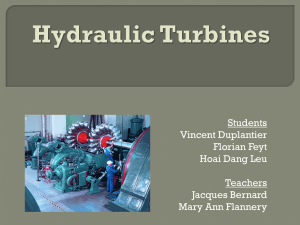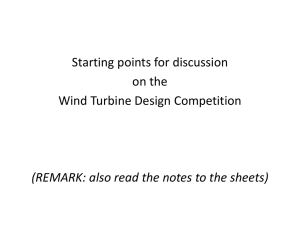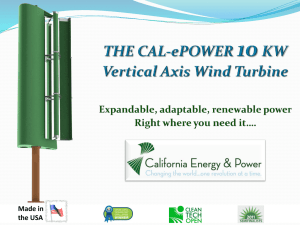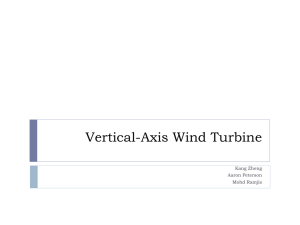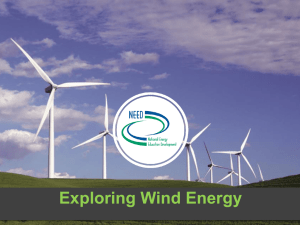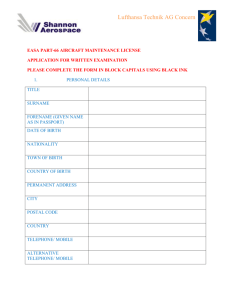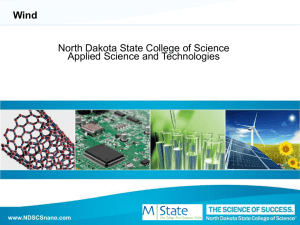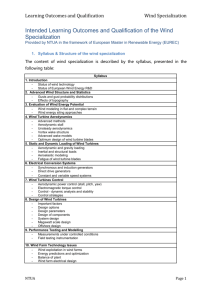AE/ME 8xxx Wind Engineering - School of Aerospace Engineering
advertisement
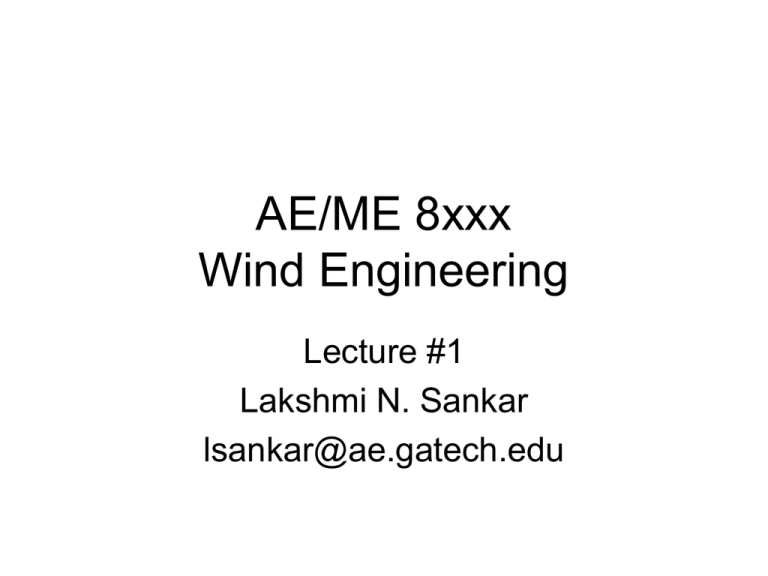
AE/ME 8xxx Wind Engineering Lecture #1 Lakshmi N. Sankar lsankar@ae.gatech.edu OVERVIEW • About the instructor • Overview of the Course – Content – Deliverables, exams, quizzes – Grading Policy – Access to instructor • Resources About the Instructor • Lakshmi Sankar • Regents Professor and Associate Chair • Room 360 • School of Aerospace Engineering • Atlanta, GA 30332-0150 • Phone: 404-894-3014 • lsankar@ae.gatech.edu • www.ae.gatech.edu/~lsankar/ About the instructor (Continued) • Courses taught include – – – – – – – – – – Introduction to AE (AE 1350) Low Speed Aerodynamics (AE 2020) High Speed Aerodynamics (AE 3021) Airfoil and Wing Design (AE 3021) Helicopter Aerodynamics (AE 6070) Wind Engineering (This course) Computational Fluid Dynamics Master’s Thesis (AE 7000) Master’s Special Problem (AE 8900) Ph D Thesis (AE 9000) About the instructor (Continued) • Research areas include – Helicopter aeromechanics – Wind turbine modeling and design – Aerodynamics of Turbomachinery – Aircraft Aerodynamics • Please see my web site for a list of publications, and Ph D students graduated in recent years. Overview of this Course • The course material will be posted on tsquare. – Look under the resource section for lectures – Look under assignments for homework/ exam/ papers and their deadlines – Look for your grades – Look for your classmates’ work at the end of the term. Overview of the Course (Continued) • All assignments will be open book and notes – You will submit your work electronically at the tsquare web site. • You will have several weeks of advance notice. • If you need an extension, please contact me early. • Write as you go, document your work as you go. • You are always welcome to contact me with questions. – E-mail is preferred!! – Telephone calls to 404-894-3014 are always welcome. Overview of the Syllabus • First few lectures will focus on – Overview of Wind Engineering (6 hours in normal chalk board lecture mode; actual time will vary depending on the mode of delivery from 3 hours to 5 hours) • • • • • • Benefits of wind energy Assessment of Wind Resources Assessment of means of energy production, consumption, and cost Green credit Wind turbine terminology and definitions First assignment will be posted after these lectures. – – You will select a wind turbine site and learn all about that site. We will show examples of what information to collect from work of your peers. Overview of the Syllabus (Continued) • Actuator disk model of horizontal axis wind turbines (3 hours) – – – – Earliest work of wind turbines modeled wind turbine as a disk across which mass is conserved, momentum is lost, and energy is lost. This theory may be learned from very simple 1-D approach dealing with the conservation of mass, moment, and energy. See www.ae.gatech.edu/~lsankar/AE2020 if you are not familiar with these concepts. We will point to these resources as we go! Overview of the Syllabus (Continued) • Review of airfoil aerodynamics (9 hours) – – – – • • • • Lift, drag, and pitching moment Panel method for airfoil analysis Modeling laminar and turbulent boundary layers, and transition Airfoil design for wind energy applications This material is intended for non-AE students who may not be familiar with these concepts. Aerospace engineers will benefit as well from a brush-up of these basic concepts. We will talk about public domain and NASA/DoD computer software for modeling airfoil aerodynamics as well. Any engineer planning to work in the wind turbine industry should master one or more of these tools and add it to the toolkit. Overview of the Syllabus (Continued) • Blade element theory (9 hours) – – – – • Inflow models based on combined blade element theory Incorporation of swirl losses in inflow Root and tip loses, and stall delay models Assessment of publicly available wind turbine modeling tools This method is similar to helicopter and fixed wing aerodynamics, but there are subtle differences. We will cover these concepts from the very basic aerodynamic principles discussed earlier. You will learn to model wind turbines using public domain solvers. • • – You may write your own in Matlab, Excel, or C or Fortran Second Assignment • Your second assignment will involve learning (or writing) your own wind turbine analysis tool. • You will validate this tool by comparing the predictions of this tool to wind tunnel and field data. – How does the power production from a wind turbine of a given configuration vary with wind speed? • This would be your second deliverable. Overview of the Syllabus (Continued) • Horizontal axis wind turbine design using blade element theory (6 lectures) – A wind turbine is classified by • • • • • • • – • Number of blades Planform (how does chord vary with radial location?) Twist distribution (how does the angle the chord makes with the plane of rotation) vary with radial location? Airfoil aerodynamic properties (How does lift, drag, pitching moments vary with the angle the airfoil makes with oncoming airstream?) Blade RPM Tower height (where is the axis of rotation placed relative to the ground?) Root cutout We will learn about how to design your own wind turbine using the tools validated in assignment #2. This would be your third deliverable. Overview of the Syllabus (Continued) • Conversion of mechanical energy into electricity (3 hours) – – – • • • Basic AC Power Generators Hybrid Power Systems Hybrid System Modeling and Simulation We will discuss the issues that arise when plugging a wind turbine (or a farm of wind turbines) to the grid. We will talk about combining wind turbines with other energy sources (diesel, gas turbines, nuclear, dry cell batteries, fuel cells, etc) We will discuss the characteristics that need to be modeled. Overview of the Syllabus (Continued) • Economic analysis of wind turbine systems (3 hours) – – – – – • You will make a case for wind energy at the site you chose way back in Assignment #1. – • We will point to public domain software that you may wish to use to conduct an economic analysis. You will be raising capital from share holders who expect a return on investment You will be borrowing the rest from a bank which charges you interest You will be selling the power to a local utility at fair market prices (cents per Kilo Watt-Hr) You may get green credit or carbon-offset credit You may end up with the conclusion that the economic conditions do not favor wind energy sites at this time, but in the future. The fourth deliverable is this economic analysis. Overview of the Syllabus (Continued) • Impact of wind turbines on the environment (3 hours) – Wind turbines help the environment – They may harm birdlife, disturb reservations or protected land, and affect commercial and residential property values • We will review how these issues are analyzed and factored into the design and construction of a wind turbine site or wind farm. Overview of the Syllabus (Continued) • Presentations by students (3 hours) – – • You will submit a final report and a PowerPoint presentation that is shared with the entire class. For distance learning students, critique of your work and constructive feedback is optional. The instructor may use your findings and artwork in future semesters. – – Do not include copyrighted or proprietary results Cite publicly available resources, get permission if it is a private communication. In summary.. • This course introduces to horizontal axis wind turbines – – – – – How they operate? How are they modeled and analyzed? How are they designed? How is the economic analysis done? What are the environmental impacts that a designer should be concerned about? • I look forward to working with you throughout the semester. • I am always just an e-mail or phone call away!

